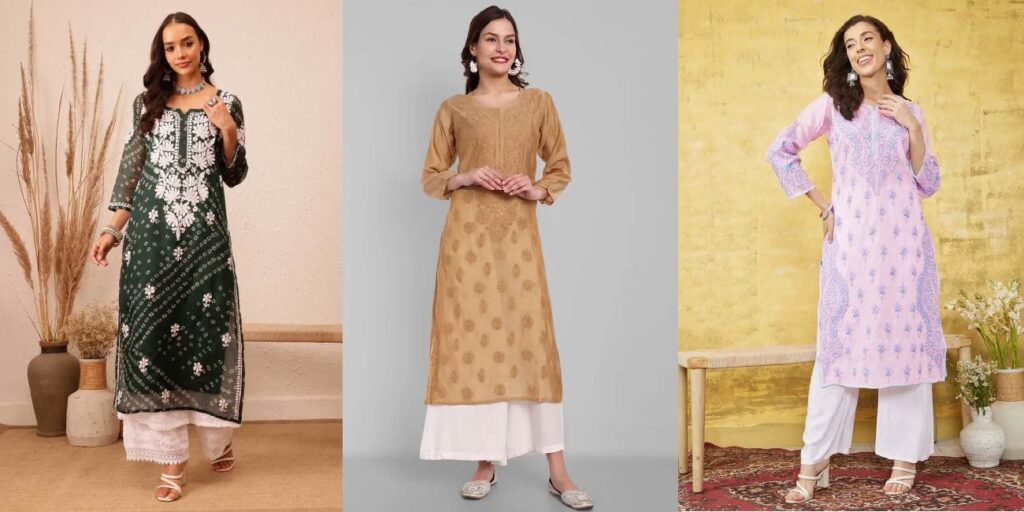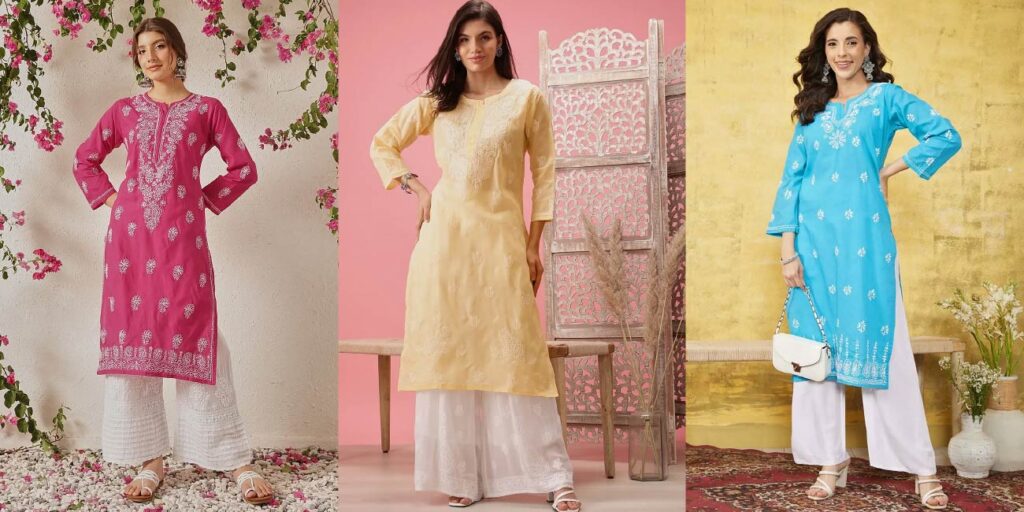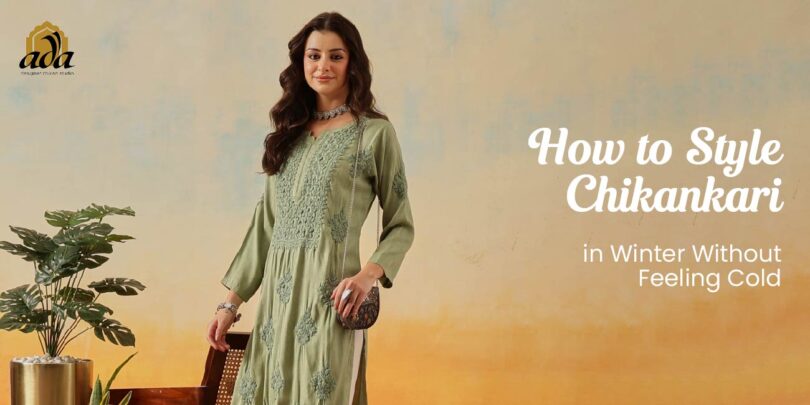If you’re wondering how to style Chikankari in winter without feeling cold, this guide will help you create warm, stylish, and elegant winter looks using your favourite chikankari kurti, chikankari kurta sets, shararas, or anarkalis. Even though chikankari is usually seen as a summer or lightweight festive outfit, with the right layering, fabrics, and styling hacks, it can become the perfect winter ethnic wardrobe essential — cozy, beautiful, and fashion-forward.
Why Chikankari Works Beautifully in Winter
Chikankari outfits are naturally lightweight and breathable, which makes them easy to layer without feeling bulky or uncomfortable. Unlike heavy zari or brocade suits, chikankari suits allow layering underneath and over the outfit while still maintaining shape and elegance.
Also, winter weddings, parties, and festivals demand something that feels premium yet not overwhelmingly heavy — and chikankari strikes that perfect balance.

Choose the Right Winter-Friendly Chikankari Fabrics
Not all chikankari fabrics are suitable for winter. Some are thin and airy, while others are warm, rich, and winter-perfect. Choosing the right fabric is the foundation of winter styling.
What To Choose & Why:
- Velvet Chikankari:
Velvet naturally feels warm, premium, and luxurious. Chikankari embroidery on velvet creates a royal outfit perfect for weddings or pre-wedding functions. - Pashmina Chikankari:
This fabric is soft, breathable, and warm — making it ideal for everyday wear or office outfits during winter. - Silk & Chanderi Chikankari:
These are festive but lightweight. When paired with lining or layering, they feel warm while looking classy. - Heavy Georgette:
The fall and structure of georgette make it a perfect party fabric. It works well with thermals underneath without appearing bulky. - Lined Cotton or Muslin:
A cotton chikankari kurta with inner lining provides warmth while maintaining a clean, classic look.
Why this matters:
Warm fabrics reduce the need for excessive layering, helping you stay cozy without hiding the embroidery.
Layer Smartly Without Hiding the Embroidery
Layering is key during winter — but it must be done so that the chikankari work remains visible.
Best Smart Layering Tips:
- Wear skin-colored thermals under your chikankari kurti:
This keeps you warm but remains invisible, allowing your kurta design to shine. - Choose fleece-lined leggings or palazzos:
These give warmth without looking bulky under long kurtas or anarkalis. - Add outerwear strategically:
Instead of heavy sweaters, choose:
- Long coats
- Velvet shrugs
- Woolen jackets
- Cape-style jackets
- Ethnic embroidered jackets
- Long coats
Why this matters:
It keeps you warm while ensuring the beauty of chikankari embroidery remains the highlight.
Pick Bottoms That Complement Winter Styling
Bottom wear plays a bigger role than we realize. Summer bottoms like cotton palazzos or chiffon shararas are too light for winter.
Best Choices & Why They Work:
- Woolen leggings:
They’re warm, slim, and perfect for shorter kurtis. - Velvet shararas or palazzos:
Ideal for winter weddings as they look regal and insulate heat. - Silk trousers or palazzos:
Soft sheen + warmth = elegant festive winter outfit. - Straight wool trousers:
Great for office or everyday wear with chikankari sets. - Jeans:
A fusion-approved, Gen-Z favorite pairing with chikankari kurti.
Why this matters:
The right bottom wear supports warmth, maintains elegance, and completes the look.
Style with Cozy Dupattas & Shawls
Layering with a dupatta or shawl enhances both warmth and style.
Winter-Friendly Dupatta Options:
- Velvet dupatta:
Heavy, luxurious, and perfect for formal events. - Pashmina shawl:
Lightweight warmth with premium texture. - Banarasi dupatta:
Works beautifully with chikankari for traditional winter festivities. - Wool blend stoles:
Perfect for casual daily wear.
Why this matters:
Instead of covering the embroidery with sweaters, you stay warm while enhancing the outfit aesthetic.
Footwear Choices That Keep You Warm & Stylish
Wearing open sandals in winter can ruin both comfort and outfit balance.
Better Winter Footwear Ideas:
- Ankle boots:
These look chic with kurtis, especially Indo-western styles. - Closed juttis with socks:
Use skin-tone socks so the look remains seamless. - Block heels or wedges:
Comfortable and winter-friendly for weddings. - Mojaris lined with fur or padding:
Warm and traditional.
Why this matters:
Right footwear keeps your overall look balanced and winter-ready.

Accessorize Smartly for a Complete Look
Chikankari styling in winter relies heavily on thoughtful accessorizing.
Best Add-Ons:
- Oxidized silver or kundan jewelry
- Velvet clutch or potli
- Statement shawl pins
- Soft glam winter makeup (warm tones, glossy lips)
Why this matters:
Accessories help shift the look from casual to festive or formal with minimal effort.
Ready Styling Ideas
| Occasion | Styling Example |
| Daily Wear | Muslin chikankari kurti + fleece leggings + wool shawl |
| Office | Georgette chikankari kurta + wool trousers + pashmina shawl |
| Wedding | Velvet chikankari anarkali + banarasi dupatta + silver jewelry |
| Casual Outing | White chikankari kurti + denim + long coat + boots |
Now that you know how to style Chikankari in winter without feeling cold, you can enjoy wearing your chikankari suits all year long — not just in summer. With the right fabric choices, layering techniques, accessories, and winter footwear, chikankari becomes a warm, stylish, and elegant winter fashion statement.
FAQs
Yes — with winter-friendly fabrics and layering, it becomes ideal for peak winter.
Use fitted thermals and fleece-lined bottoms instead of bulky sweaters.
Yes! It’s one of the top winter ethnic fashion trends.
Yes, pairing a chikankari kurti with a structured blazer creates a stylish Indo-western fusion look. Choose neutral blazers like black, beige, or tan so they complement the embroidery.
Thermal inner tops, fleece camisoles, and heat-tech inners are the best options. Choose thin innerwear that sits flat and doesn’t create bulk under your chikankari kurta.
Absolutely! Choose fabrics like velvet, pashmina, silk, or heavy georgette paired with velvet dupattas or shawls. Add warm-toned jewelry and winter-themed makeup to complete the festive look.
Long trench coats, woolen overcoats, velvet shrink jackets, ethnic embroidered jackets, and cape-style jackets pair beautifully with chikankari outfits without hiding the embroidery.
Yes, ankle boots and block-heel boots pair well with chikankari kurtis, especially for casual or Indo-western looks. For weddings, juttis or velvet mojaris are a more traditional option.
Wear thin cotton or wool-blend socks in skin tone or matching colors. Many brides and wedding guests now wear socks with juttis during winter — it looks seamless and stylish.
Yes — but for winter styling, balance pastels with deeper layers such as navy, maroon, charcoal, emerald green, or gold-toned shawls to add warmth and contrast.
Explore more styles, stories, and shopping tips on Ada Chikan Designer Studio.
Best Outfits for Winter Weddings 2025 – Chikankari Edition
Accessorizing Chikankari: Jewelry, Bags & Dupattas for Wedding Functions
Ada Chikan in Mumbai: Ada Brings Royal Chikankari to the City of Dreams







